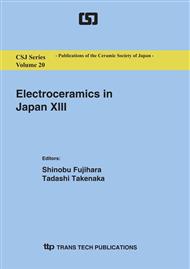p.100
p.105
p.109
p.113
p.117
p.123
p.127
p.131
p.135
Influence of Sintering Behavior of ZnO Nanoparticles on J–V Characteristics of ZnO-Based Dye-Sensitized Solar Cells
Abstract:
Dye-sensitized solar cells (DSSCs) are one of the promising photovoltaic devices because of their lower manufacturing cost and higher energy conversion efficiency. Wide-gap, porous semiconducting metal oxides are generally used as electrode materials of DSSCs. Previously we utilized ZnO as DSSC electrodes and achieved a high conversion efficiency of 6.58% by improving the structure of ZnO films. However, open-circuit voltage (VOC), one of the factors to determine the performance of DSSCs, was still at a lower level (≈ 0.60 V) than that of common TiO2-based cells. We believe that the lower VOC is due mainly to the occurrence of recombination. In this work, we tried to enhance VOC by controlling the heating process of electrodes and suppressing the recombination for further development of ZnO-based DSSCs. As a result, we have achieved a higher VOC of 0.725 V, confirming that the sintering behavior (grain growth and/or necking of grains) influenced largely the characteristics of DSSCs.
Info:
Periodical:
Pages:
117-120
Citation:
Online since:
July 2010
Authors:
Price:
Сopyright:
© 2010 Trans Tech Publications Ltd. All Rights Reserved
Share:
Citation:



